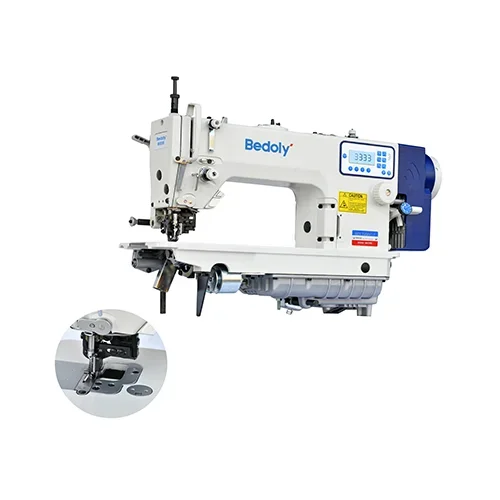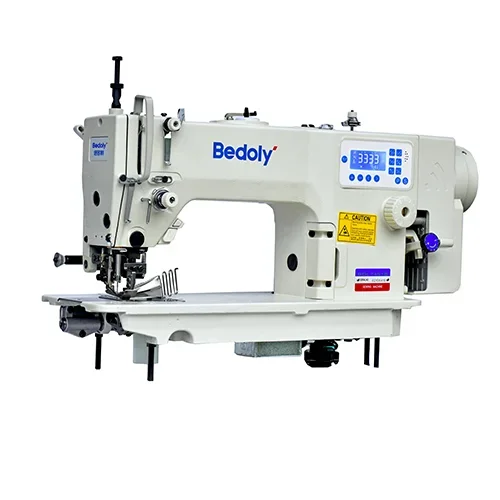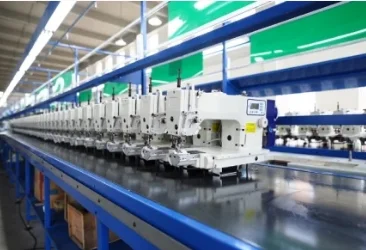In the competitive landscape of garment manufacturing, efficiency and precision are paramount. Computerized side cutter sewing machines have emerged as essential tools that significantly enhance production processes. These machines not only streamline operations but also improve the quality of finished products, making them indispensable in modern apparel manufacturing. This article explores the various features, advantages, and applications of computerized side cutter sewing machines, highlighting their role in revolutionizing production workflows.
Understanding Computerized Side Cutter Sewing Machines
What Are Computerized Side Cutter Sewing Machines?
Computerized side cutter sewing machines are advanced sewing devices equipped with integrated cutting mechanisms that allow for simultaneous sewing and cutting of fabric. This dual functionality enables manufacturers to produce garments more efficiently by reducing the number of operational steps involved in the sewing process. These machines are particularly beneficial for producing knitwear, T-shirts, and other garments that require precise edge finishing.
Key Components
The main components of a computerized side cutter sewing machine include:
Sewing Head: The primary unit responsible for stitching.
Cutting Blade: An integrated blade that cuts fabric edges while sewing.
Control Panel: A user-friendly interface for programming and controlling machine functions.
Needle Cooling System: Prevents overheating during high-speed operations, ensuring consistent stitching quality.
Dust Collection System: Maintains a clean working environment by collecting fabric dust and debris.

Advantages of Computerized Side Cutter Sewing Machines
Enhanced Efficiency
One of the most significant advantages of computerized side cutter sewing machines is their ability to enhance operational efficiency. By combining sewing and cutting processes into one step, these machines reduce the time required to complete each garment. For instance, a typical machine can operate at speeds up to 5,000 stitches per minute, allowing manufacturers to meet tight production deadlines without sacrificing quality.
Improved Precision
Precision is critical in garment manufacturing, especially for high-quality products that demand impeccable finishing. The computerized nature of these machines allows for exact stitch placement and cutting accuracy, minimizing errors that can lead to fabric waste. With advanced technology, manufacturers can achieve consistency across all garments produced.
Reduced Material Waste
The integrated cutting mechanism significantly reduces material waste compared to traditional sewing methods. By cutting the fabric as it is sewn, manufacturers can optimize fabric usage and minimize scrap material. This not only lowers production costs but also supports sustainability initiatives within the industry.
Increased Flexibility
Computerized side cutter sewing machines offer increased flexibility in terms of design capabilities. Manufacturers can easily adjust settings to accommodate various fabric types and garment styles, allowing for a diverse product range without requiring extensive reconfiguration or downtime.

Applications in Garment Manufacturing
Knitwear Production
Knitwear production benefits immensely from computerized side cutter sewing machines due to their ability to handle stretchy fabrics effectively. The simultaneous cutting and stitching ensure that seams remain intact without distorting the fabric.
T-Shirt Manufacturing
In T-shirt manufacturing, speed and precision are crucial for maintaining competitive pricing and quality standards. These machines enable quick production cycles while ensuring clean edges on collars and hems.
Sportswear and Activewear
The activewear market demands high-performance garments with precise fits and finishes. Computerized side cutter sewing machines allow manufacturers to meet these demands by providing accurate cuts and strong seams essential for durability.

Technological Innovations Driving Efficiency
Advanced Control Systems
Modern computerized side cutter sewing machines are equipped with sophisticated control systems that allow operators to program complex stitching patterns easily. These systems can store multiple designs, enabling quick transitions between different garment styles without manual adjustments.
Needle Cooling Technology
To prevent overheating during high-speed operations, many machines incorporate needle cooling technology that maintains optimal temperatures, reducing thread breakage and ensuring consistent stitch quality.
Dust Collection Systems
An advanced dust collection system enhances the longevity of the machine by preventing dust accumulation on critical components, thus reducing maintenance needs and downtime.

Conclusion
Computerized side cutter sewing machines represent a transformative advancement in garment manufacturing technology, providing numerous advantages such as enhanced efficiency, improved precision, reduced material waste, and increased flexibility across various applications. As manufacturers continue to seek ways to optimize their production processes while meeting stringent quality standards, investing in this advanced equipment becomes essential for staying competitive in today's market landscape.
By embracing these innovations, manufacturers can not only enhance productivity but also better meet customer demands while contributing positively toward sustainable manufacturing practices—ultimately positioning themselves as leaders in their respective industries. This comprehensive overview highlights how computerized side cutter sewing machines streamline production processes while addressing challenges faced by manufacturers today. As technology continues to advance, these machines will play an increasingly vital role in shaping the future of garment manufacturing.
Computerized Side Cutter Sewing Machines: A Comprehensive Overview

